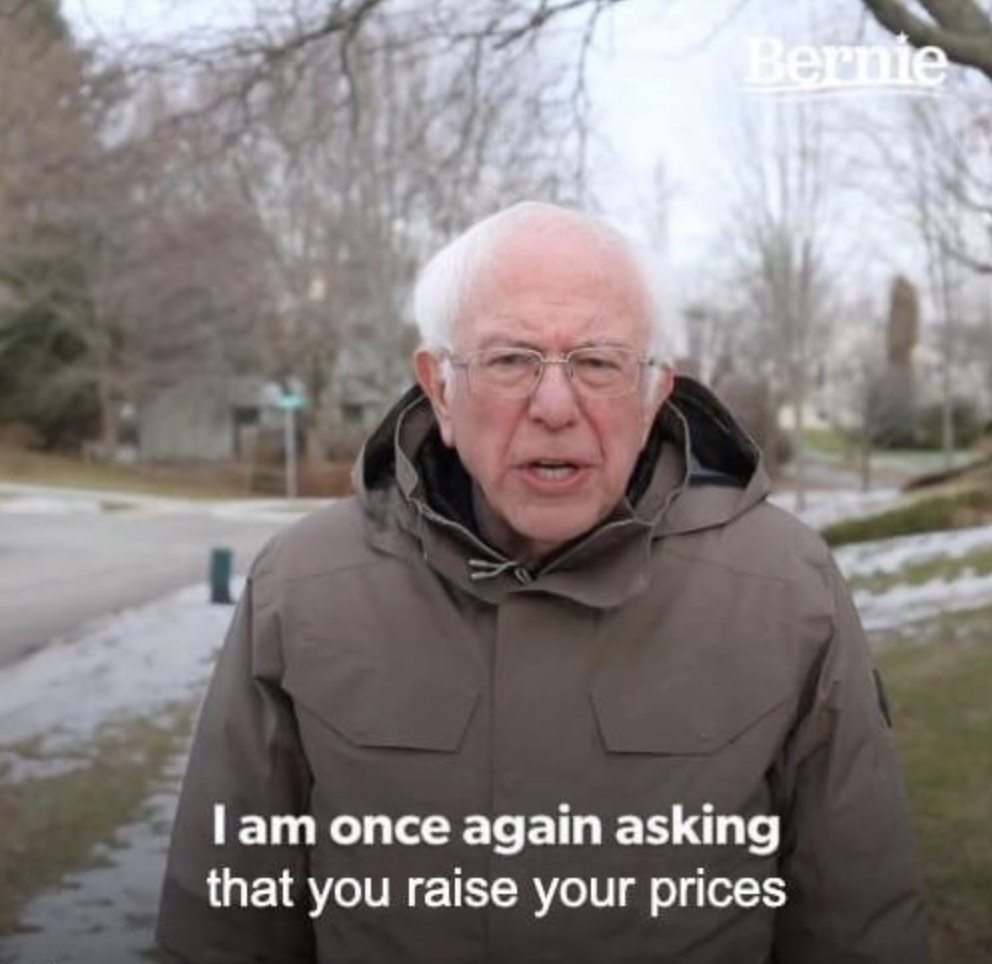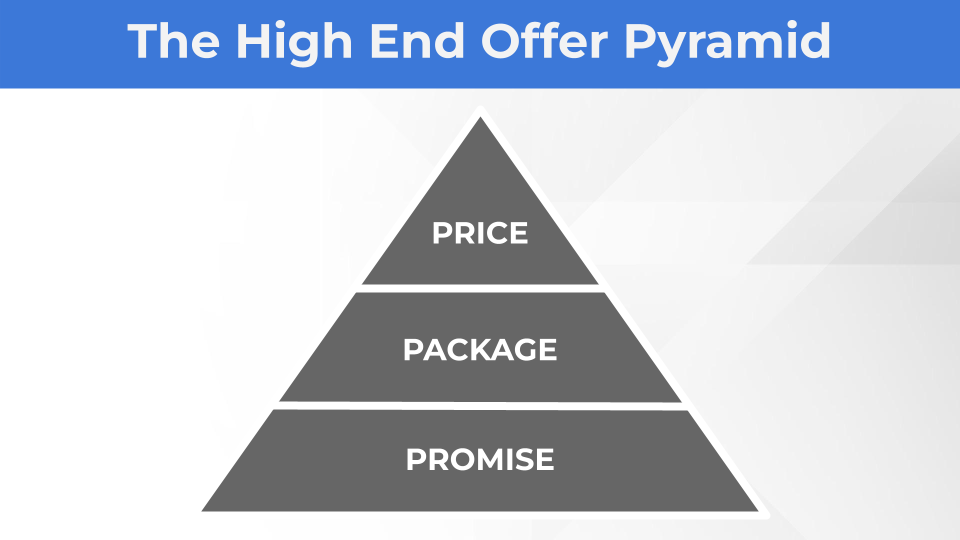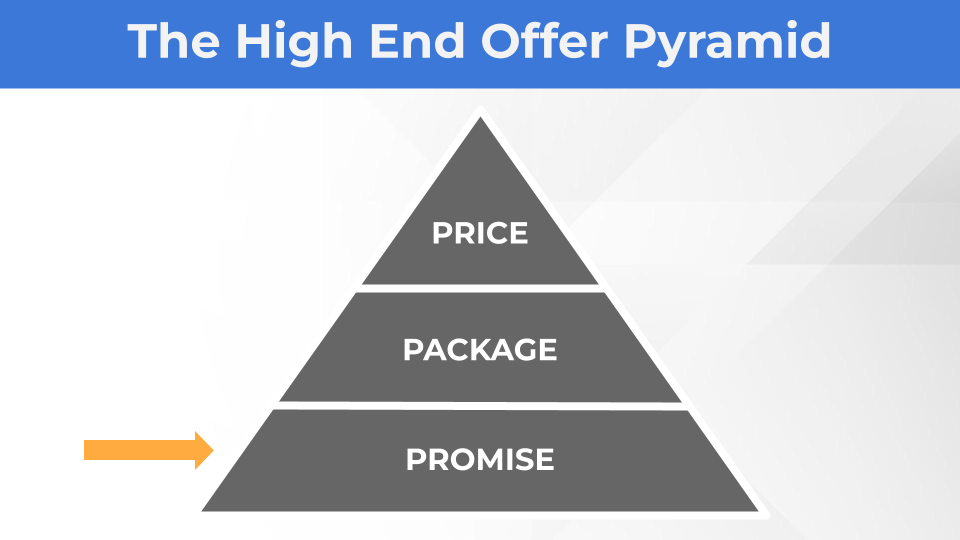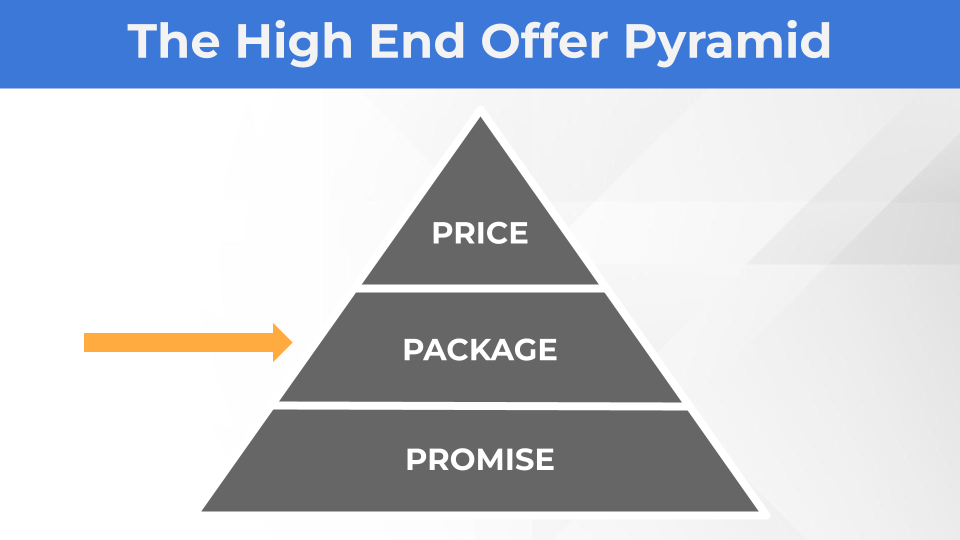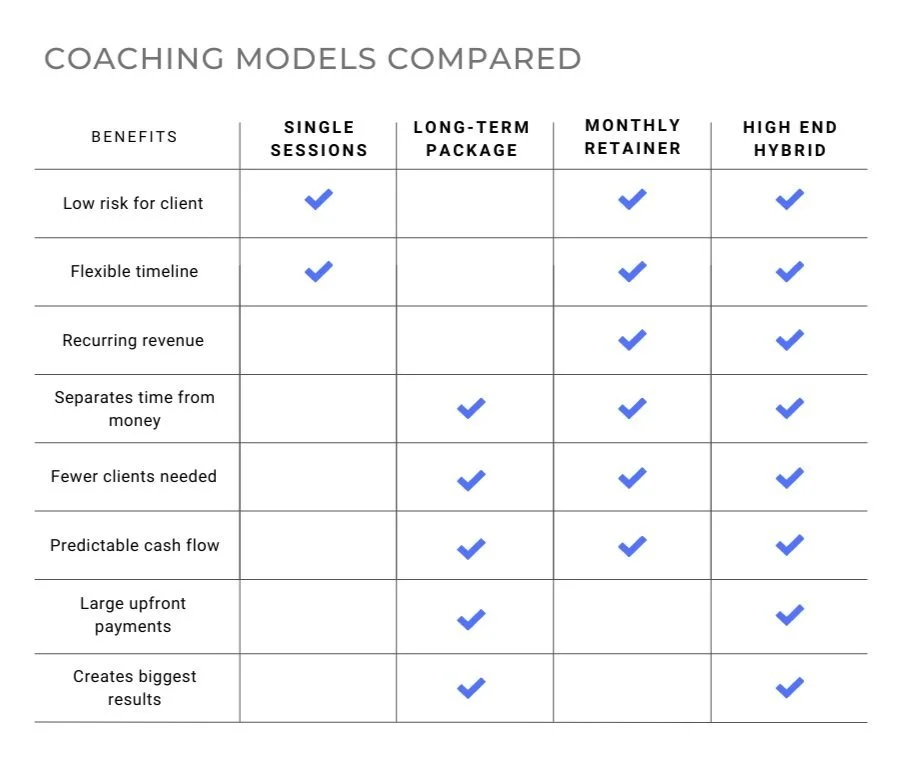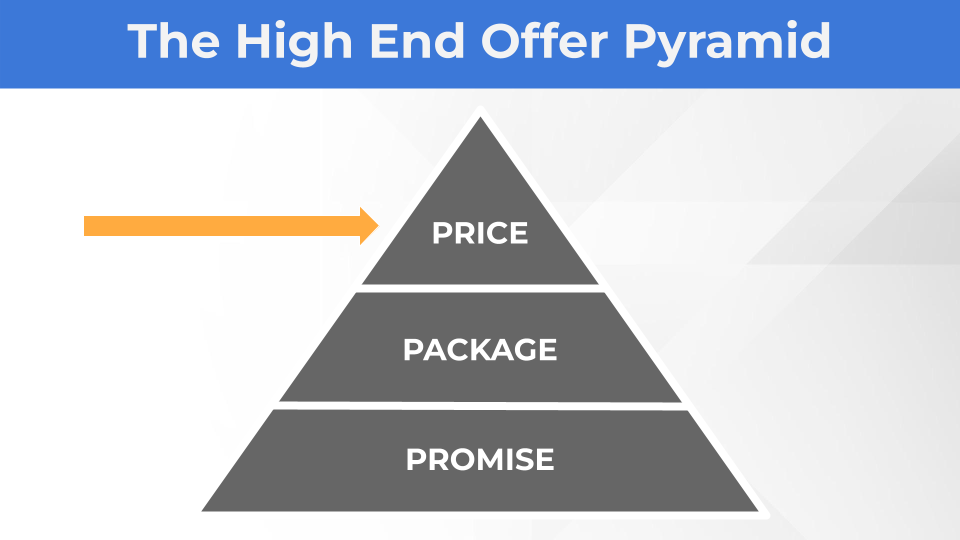How to Create a $5,000+ Coaching Package (3 Steps)
I started off as a life coach charging $75 per session.
The first time I got paid $5,000 upfront, I kneeled down on the floor and hugged my office chair.
Now I charge $15,000+ per coaching package and use a standing desk.
So I just sorta stand there.
Charging high-end prices has allowed me to:
Spend less time marketing and selling
Take on fewer clients
Create better case studies
It becomes a virtuous cycle. That’s why…
But it’s not about charging more just for the hell of it. It’s about creating a coaching package so valuable that it’s still a steal for your clients. Even at $5,000 or more.
Over the years, I’ve helped hundreds of coaches turn their expertise into high-end offers. It doesn’t matter if you’re selling life coaching, executive coaching, or business coaching. You just need to follow three steps.
In this article, you’ll learn:
Table of Contents
Before you dive in…
If you want real examples of how my clients are pricing and packaging their services, I’ve put it into a PDF for you. I think you’ll be surprised by how simple the offers are.
Click the button below to download:
The High End Offer Pyramid
You could just raise your rates a little without changing anything else. And for some coaches, this is a great idea. They’re currently undercharging.
But if you want to significantly increase your prices, you’re going to have to create an offer so valuable that people are happy to pay $5,000+ for it.
You can do this using what I call The High End Offer Pyramid.
Each step of the pyramid builds on the one beneath it. Which means that before we can get to your packaging and pricing, we need to start with what makes an offer attractive: the promise.
Step 1: Clarify Your Promise
Many coaches get stuck on their coaching niche because they feel like they have to narrow their entire business down to one thing.
It's much less intimidating to build a niched offer instead. One primary thing that you sell and stand confidently behind.
When you build a niche offer, you can charge more for it. Plus…
You have less competition
You can clearly describe what you do
Your coaching is more effective because it's specific
If you've got an offer that people are paying for, it's your choice whether you want to make that your entire brand, or create new offers over time.
If the offer doesn't sell, no sweat. You don't have to change all the messaging on your website. You just test the next offer.
When developing an offer, ask these questions:
1. Who can I help the most? For this, it’s great to choose a group that congregates in one place so that you’ll know how to reach them. For example, my target market of coaches can be found at certain conferences, certification programs, and online groups. Choose a group of people who you are genuinely interested in supporting.
2. What can I help most with? This should be be specific, tangible, and compelling. It should be an urgent problem that your target market actually wants to solve. For example, coaches come to me when they aren’t getting consistent clients. An easy way to do this is to coach people on a problem you’ve already solved for yourself.
These two questions point to where you can create something of significant value.
And when you create more value, you’re able to charge more.
The first step in doing this is to get clear on your promise. A promise is when you say, “If you’re this type of person, with this problem, I can help you accomplish this thing.”
You need to choose an outcome that people will pay at least $5,000 for. Or, to look at it another way, the problem you can solve has to be costing them at least $5,000 right now.
For example, my client Grace has a high end, 1-1 offer that helps entrepreneurs break the habit of procrastination and perfectionism so that they can free up time and headspace. When they no longer resist growth-related actions out of fear, they’re more likely to increase their revenue and opportunities.
This promise helped her sell $110k worth of coaching in a single month while working with me. Not bad.
The best promises are specific
They help one person, with one painful problem, to achieve one specific result. When it comes to who you’re helping, make sure that group has the money to actually pay you. It’s like this quote from Alex Hormozi:
Solve rich people’s problems. They pay better.
-Alex Hormozi
The best promises speak to a financial ROI
In plain english, this means that they directly or indirectly help the client make more money. Even though Grace helps her clients with something intangible (mindset, fear of failure) she links it to a tangible result (you stop procrastinating and your business grows). This isn’t essential, but it makes your life easier.
The best promises sell surgery, not prevention
You want to focus on a big, painful problem that the client is currently experiencing. Not something in the distant future that they haven’t started thinking about yet.
If you’re not sure what your promise should be, use your best clients as a jumping off point. What did they come to you for? What did you help them achieve?
Here’s what your promise should look like when it’s done.
“My program helps [person] solve [problem] so [promise].”
Your promise is the foundation of your offer, so it’s worth taking some time to get this right. Once you have it, proceed to step 2.
Step 2: Create Your Package
There are four main ways to structure a coaching engagement.
Single sessions
Long-term packages
Monthly retainers
Hybrid (I’ll explain in a sec)
You can also offer retreats, group programs, online courses, membership sites, etc.
But for this article, we're going to focus mostly on 1-1 coaching. That’s the place to start. I have a broader article that compares the best and worst business models for coaches.
Let's start with a rundown of your 4 main packaging options:
Long-term packages and single sessions create an "opt-in" relationship. The client must decide to re-up at the end of a session or package. Long-term packages offer larger upfront payments and better results.
Monthly retainers create an "opt-out" relationship. You keep going until the coach or client decides it's no longer valuable. Monthly retainers offer reccuring revenue and a flexible timeline.
This is why I recommend a hybrid model: package first, then retainer.
You might think it’s harder to sell a package than a retainer, but that hasn’t been my experience.
A couple years ago, I experimented with only selling retainers. My conversion rate actually went down slightly compared to selling a 6 month coaching package. I think this is because packages feel more tangible, and thus easier to buy.
Let’s look at each one of them in detail…
🕐 1. Single Sessions
Also called hourly billing. Client pays for single sessions with you, either on a one-off basis or in a bundle. A bundle is like a punch pass at a gym. For example, you could sell 6 sessions in bulk for your client to schedule as they please. Single sessions can be a good way to “get in the game” and work with your first few paid clients. Just don't get stuck at this stage.
Pros:
✅ Low risk for client. Single sessions are the easiest to sell since the client only has to commit to a single session. So if you’ve never gotten paid for business or life coaching, single sessions are a good way to build your confidence. They can also be offered as part of a one-time promotion if you already have an audience and need a quick influx of cash.
✅ Flexible timeline. Single sessions allow the client to purchase the exact amount of coaching they need. They also allow the coach to stop working with a client whenever they want.
Cons:
❌ No recurring revenue. Single sessions require the client to “opt-in” each time they want coaching as opposed to “opting-out” to an ongoing agreement. Because of this, the coach often has to remind clients to book another session.
❌ Doesn’t separate time and money. With single sessions, you get paid in direct proportion to the time that you work. If you want to make more money, you have to either work more or charge more. This model is not scaleable.
❌ More clients needed. With single sessions, you tend to work with each client for a shorter amount of time. So you need to constantly find new ones.
❌ Less predictable cash flow. You won’t know how many people are going to book sessions each month. With packages and retainers, you’ll have a better sense.
❌ No large upfront payments. You can sell a bundle of single sessions, but it’s hard to charge really high prices without the context of a package. People may compare your offer to lower priced services, like buying a bundle of yoga classes. You often end up chasing people down to schedule their next call.
❌ Creates smaller results. Because engagement lengths tend to be shortest with single sessions, you’re only able to support the client with a small scope of challenges. This makes your case studies less impressive.
Best for: Beginning coaches who have never charged for coaching
📦 2. Long-Term Packages
Clients pay for multiple sessions, within a defined length of time. Packages may also include group sessions, access to trainings, support between calls, and more. When done well, these packages are niched down and revolve around one primary goal. For example, a health coach might offer 3 month packages that help busy professionals lose 20 pounds without dieting.
Pros:
✅ Separates time and money. Well-designed packages allow you to charge based on the results of your coaching instead of on the time you spend. This means that the better you get delivering your package, the more you make. The better you get with single sessions, the less you make.
✅ Fewer clients needed. Since you work with each client for a longer period of time, you don’t have to constantly market yourself. You can just focus on coaching.
✅ More predictable cash flow. With packages, you know how many people are going to be booking sessions each month. You’ll still need to learn how to generate leads consistently, but packages are less stressful than single sessions.
✅ Large upfront payments. When you sell long-term packages, you can often secure some or all of the payment upfront. This allows you to invest in your business sooner, which ultimately makes you a better coach and entrepreneur. You can try to sell a bundle of single sessions, but it’s hard to charge a lot without the context of a package.
✅ Creates biggest results. Because engagement lengths tend to be long with packages, you’re able to support your client through their full transformation. This provides awesome case studies. With single sessions and retainers, it’s more likely that your client will drop off when things get hard. One thing to watch out for with packages is complacency. Unless the coach and client both stay in touch with the goal of the engagement, there may be a big rush of energy at the beginning that dissipates over time.
Cons:
❌ Higher risk for client. Because the client is committing to a more long term relationship, you’ll need to build more trust in order to make the sale. This can be overcome in various ways: creating useful content, generating referrals, providing successful case studies, and by running an effective enrollment conversation.
❌ Less flexible timeline. When you design a package, you make an educated guess on the amount of time it will take someone to reach their desired outcome. However, the client isn’t able to purchase the exact amount of coaching they need. Packages also lock the coach in for a certain amount of time. It’s hard to end a long-term package midway through simply because you don’t enjoy working with that client.
❌ No recurring revenue. With packages, you know you’ll be working with a client for a certain amount of time. But that revenue isn’t technically recurring. Which means you’ll need to re-enroll them once the package ends. Given the discrete nature of the package, your client may assume the engagement ends when the package ends. So if that’s not the case, you’ll need to create an expectation of ongoing work together.
Best for: Coaches who know their niche and want more cash upfront
📆 3. Monthly Retainers
Client pays a set monthly fee for access to your coaching, support, and content. Monthly retainers do not lock the client into a set number of months. When done well, the client gets charged automatically on the same day each month.
Pros:
✅ Low risk for client. With a retainer, you can always say to the client, “Let’s just start with the first month and see how it goes.” But this doesn’t necessarily mean it’s easier to sell a retainer than a package. Some people don’t like signing up for subscriptions, and would prefer to invest in a defined goal and timeline.
✅ Flexible timeline. Retainers allow the client to purchase the exact amount of coaching they need. They also allow the coach to stop working with a client whenever they want. If you decide to sell a retainer, you may want to require that the client give 2-4 weeks notice before canceling so that you can replace them.
✅ Recurring revenue. All things being equal, a business with recurring revenue is more valuable. That's because recurring revenue lends itself to repeat business. The more repeat business you have, the less time you spend marketing.
✅ Separates time and money. Your retainer can include more than just coaching sessions. When selling monthly retainers, I like to give an expected timeline based on their goals. This allows you to still sell in a results-focused way. For example, I might say "Most of my clients hit that revenue mark about three months in."
✅ Fewer clients needed. A monthly retainer doesn’t guarantee that clients will stay with you for a certain amount of time, but they generally require fewer clients than a single session model. Instead of buying a minimum of one session, each client buys a minimum of one month.
✅ More predictable cash flow. Long-term packages put the focus on sales. Monthly retainers put the focus on churn. Churn is the percentage of clients who leave each month. Instead of starting each month at 0$, you’ll be able to estimate the amount of recurring payments that will go through based on churn. You can reduce churn by improving the client experience.
Cons:
❌ No large upfront payments. In a traditional monthly retainer, you’ll only ever get paid one month at a time. This is not ideal for cash flow. You’ll be less able to make investments that could grow your business and skillset.
❌ Creates inconsistent results. The main strength of a monthly retainer – flexibility – is also its weakness. Change takes time. With a monthly retainer, you risk the client leaving when things are hard. Unless you’re able to create results in the first month or two, you’ll lose out on that potential case study.
Best for: Reccuring revenue, longer engagements that require a flexible timeline
🏅 A Fourth Option: The “High End Hybrid”
You can tick all of the boxes by combining a long-term package with a monthly retainer. I call it the High End Hybrid. In my opinion, it’s the ultimate coaching model. Here’s how to do it:
First, figure out the length of time that you’d need to work with someone in order to ensure a phenomenal case study.
This could be 3, 6, or even 12 months. Basically, we want to support them through the entire transformation from start to finish.
If you’re a health coach, work with them until they’ve hit their 20 pound weight loss goal.
If you’re a business coach, work with them until they’ve hit their $20k per month goal.
If you’re a career coach, work with them until they’ve transitioned into work they love.
The timeline of your coaching depends on your promise. Every client will be different, but there’s usually a minimum length of time required to hit the goal.
That should be the length of your initial package.
At the end of the package, you can transition that client to a monthly retainer.
Obviously, you should only offer this if it serves the client and you want to keep working with them.
The monthly retainer should be equal to or less than the monthly cost of your package.
For example, if you charge clients $5k for a 3 month coaching package, the monthly retainer should be $1,500 or less. In most cases, you can charge less and offer less because your client won’t need as much support post-package. If you were to charge $1,000 for your monthly retainer, and include fewer calls each month, it would feel like a steal compared to the initial investment.
I used to feel like retainers created dependency between coach and client. It’s actually the opposite. There are certain cases where the client needs to continue on just a bit longer in order to hit their stride. I’ve had it happen where a client achieved more in the two month retainer than they did in the whole 6 months of the package - they just needed those one or two extra insights and they were ready to go off on their own.
The final thing to consider is a guarantee.
This is not required, but it can help to lower the risk for your clients. Especially if you haven’t created a lot of case studies yet.
There are two different types of guarantees: conditional and unconditional. Conditional guarantees require the client to do certain things before they can ask for their money back. Unconditional guarantees do not. Clients have to meet certain criteria in order to qualify: for example, scheduling and attending all their calls, watching certain videos, and/or taking certain actions.
I wouldn’t recommend offering an unconditional guarantee for the entire length of your package, but you could offer one for up to a month. For example, you could offer a 14 day unconditional guarantee - if they change their mind after the first call or two, you’ll give them a full refund. This eliminates the risk for them and makes your package easier to sell. You can make this a normal part of your sales process or save it as a last-resort when a potential client is on the fence. You can also combine this with a conditional guarantee.
There are different types of conditional guarantees:
My favorite is a “release of service” guarantee. This means that if they do everything that’s required and still don’t achieve a certain milestone, they don’t have to continue on. The reason I like this guarantee is that it still honors the time you’ve put in. It keeps the client committed, while also giving them an out.
A spin on this is a “delayed second payment” guarantee. For example, they don’t have to pay the second installment until they lose 5 pounds, get 3 clients, or land a job interview.
You can also do a “coach them free until the result” guarantee. So let’s say they pay upfront, but they don’t haven’t quite gotten the result by the end of your package. You can coach them for free until they do.
Or you could do a straight up money back guarantee, but only if certain conditions are met.
The High End Hybrid: a long term package, plus retainer, plus guarantee. It’s a great model.
What To Include In Your Coaching Offer
Structure your offer based on what will best serve your clients.
First, think about the main thing that your clients come to you for. Then ask...
"If I were in my client's shoes, what type of support would help me reach my goals?"
"What would I not want?"
"What would practically guarantee my success?"
Make a list.
The list can include things like:
Monthly coaching calls
Access to live or prerecorded trainings
Email or Voxer support between calls
A virtual or in person retreat every three months
Access to a mastermind with your other private clients
The sky's the limit. Remember, we’re going high end with our pricing. That means we have lots of margin to go above and beyond for our clients.
Once you have your list in front of you, I want you to cross out things that you're not willing to do. For example, maybe you don't want to offer support between calls.
Then, cross out the things that don’t actually add that much value to the package.
Finally, I want you to write the words "so that" next to each remaining item and explain why you've included it.
For example, maybe you offer Voxer support so that your clients can get their questions answered between calls and make faster progress.
The "so that" exercise forces you to justify each component of your retainer. It also gives you a script to follow when you speak with potential clients.
Next, decide what to include in your coaching contract. These are your "rules of engagement."
Here’s an example of some things I include in my monthly retainer contract:
Client must notify me at least two weeks before their next payment goes through if they want to cancel.
Client or coach can "pause" the retainer for one month. This allows for a break in coaching and payment without canceling.
A late fee in the case of a monthly payment not going through after x number of days. Termination after 30 days of no payment.
Step 3: Choose Your Price
There are two strategies when it comes to choosing your coaching fees:
Option A. Charge as little as possible, market like a crazy person, and take on a million clients. This is the path to burnout.
Option B. Charge a lot, learn to sell at those prices, and give your attention to a small handful of committed clients.
If you’re just getting started, here’s what to charge your first coaching client.
Otherwise, I'd recommend you choose Option B. It's more sustainable in the long run.
High end coaching requires that you move towards results-based pricing. Instead of charging for your time, you charge based on the results of your coaching.
Most people don't do this. They start with a price that seems reasonable and then decide how many sessions they can do for that price. The client does the math on what each session costs instead of focusing on results.
Here are three ways to choose your price:
Play the higher/lower game. I got this from Michael Neill in his book Supercoach. He says, “Choose any number to start and ask, “Is it [this number]?” The only three acceptable answers are “Higher,” “Lower,” or “That’s it!” You keep playing until you arrive at the right price.
Use the ROI test. While the higher/lower game helps you tap into your intuition, the ROI test is more logic based. If they achieve the promised result, what will the coaching be worth to them? You want to make it so they get a positive return on investment. For example, I can say to potential clients, “Even if you only get 2 new high end clients with my help, the coaching will pay for itself.”
Watch your conversion rate. This one is great if you’re already selling a high end offer. The goal is to turn 25-50% of free consults you have to into clients. Below 25% and you either need to lower your price or increase your sales skills. Above 50% and you’re probably undercharging.
Most offers that I would consider high-end are $5,000 or more. If that amount sounds crazy to you, I understand. It seemed crazy to me at first too.
But then I realized that by undercharging, I was doing a disservice to my clients. I wasn’t able to include a high level of support. And it wasn’t sustainable for my business.
I recommend offering 2 payment options: upfront or monthly (upfront should cost 10%-15% less to incentivize that option).
Pick a price and go. You can always adjust it up or down once you’ve started selling.
The truth is, no one can tell you exactly what to charge. What matters is your level of confidence. You can always raise your coaching rates as you get better.
Use This Formula To Test Your Pricing
I call it the Capacity Equation. It goes like this:
Capacity = Monthly Revenue Goal / Monthly Revenue Per Client
For example...
Let's say you want to make $10,000 per month. This is your monthly revenue goal. Keep in mind that this is revenue, not income. You'll need to account for expenses.
And let's say you charge $500 per month, per client. If you charge upfront, that's great - just divide by the number of months in your package to get this number.
Now plug those numbers into the formula:
Capacity = Monthly Revenue Goal / Monthly Revenue Per Client
If you charge $500 per month:
Capacity = $10,000 / $500
Capacity = 20
So based on your current pricing, you'll need to work with 20 clients at a time to hit your revenue goal. Look at what each package includes. Are you willing and able to do that for 20 people?
When most people do this exercise, their response is, “Oh crap, I’m not charging enough!”
If you're not sure about your pricing, you can use the formula to play with some options.
Let’s say you charge $2,500 per month:
$10,000 / $2,500 = 4 clients needed
It doesn't take a mathematician to realize that the higher your prices are, the fewer clients you need to hit your revenue goal.
Which means you don't need to book as many consults. Which means you don't have to do as much marketing.
That's right: higher prices = less marketing.
Higher prices also mean less chance of burnout, more attention for each client, and better case studies.
It's an upward spiral.
That's why my most successful clients raise their prices when they work with me:
Angelina doubled her prices after clarifying her true niche
Rachel quadrupled her prices and filled her roster in 2.5 months
Ryan had his first $10,000 month after increasing his prices
Chase doubled his revenue and cut his client hours in half
Corrie landed her first $9,000 client within 3 months of working with me
Max went from charging $125 per hour to $6,000 per package
If you want results like these, learn more about working with me.
FAQs About Coaching Packages And Pricing
Let's dive into some FAQs:
Do I need to name my coaching package?
If it’s a 1-1 offer, you don’t need to name your coaching package. For a group program, I like having a name. Think about the result or identity that your clients want when brainstorming names. Try to use use alliteration and/or rhyming to make it memorable.
Should I have more than one type of package?
A lot of coaches think that they’re supposed to have three options, sort of like the tiers that you see for software products. You can certainly test this, but the simplest way to start is to focus on one offer, with two options for pricing (upfront or monthly). Instead of trying to decide which package to go with, your clients will just be deciding between how they want to pay. Create one package that completely solves the clients problem and sell that.
Do I need a signature system that I take clients through?
Overtime, you’ll want to create a process that helps your clients get consistent results.
For 1-1, I think it’s too restrictive for the coach to bring a topic for every single session. And it can be disempowering for the client. But I do like have 3-5 main areas I focus on in order to help clients reach their goal. I keep that big picture in mind so that they don’t end up missing something big that they don’t know about.
When you build a course or group program, that’s when you want to have a more specific structure for people to follow (because you can’t coach them 1-1).
For more, read Signature System Tips: How To Create A Coaching Program That Clients Love.
Should I list prices on my website?
In most cases, when you’re charging high-end prices, you shouldn’t list prices on your website.
How do I choose between the different package types?
If you’ve never gotten paid for coaching before, your first step is just to sell a single session at any price. After that, I recommend the High End Hybrid: a long-term package with a retainer on the backend.
3 Examples of Successful Coaching Packages
If you want some more examples of business and life coaching packages that my clients are selling right now, I’ve put all the details into a PDF for you.
Click the button below to download:
If you enjoyed this article, read this one next: How to charge 10x more than your competitors.

